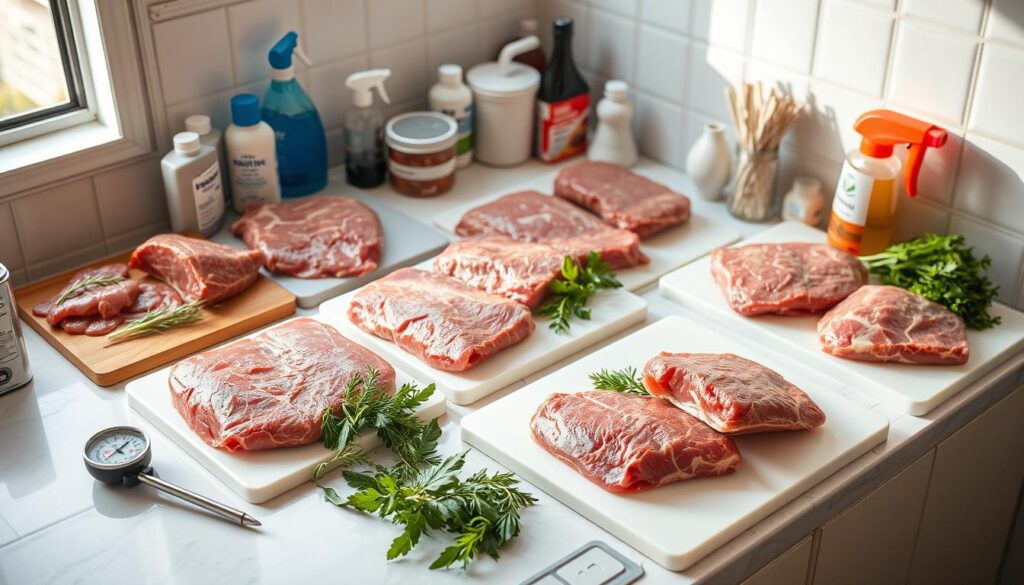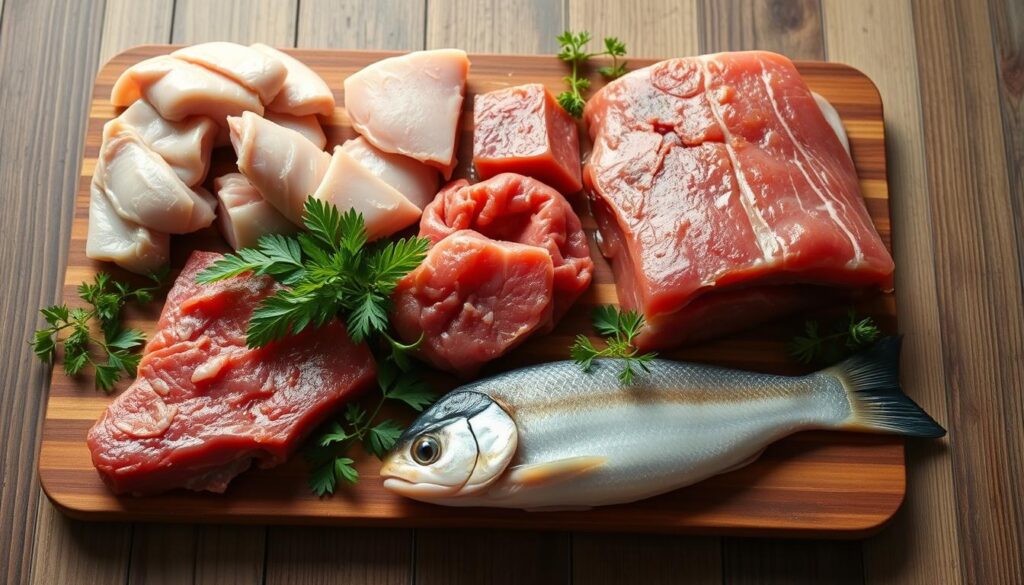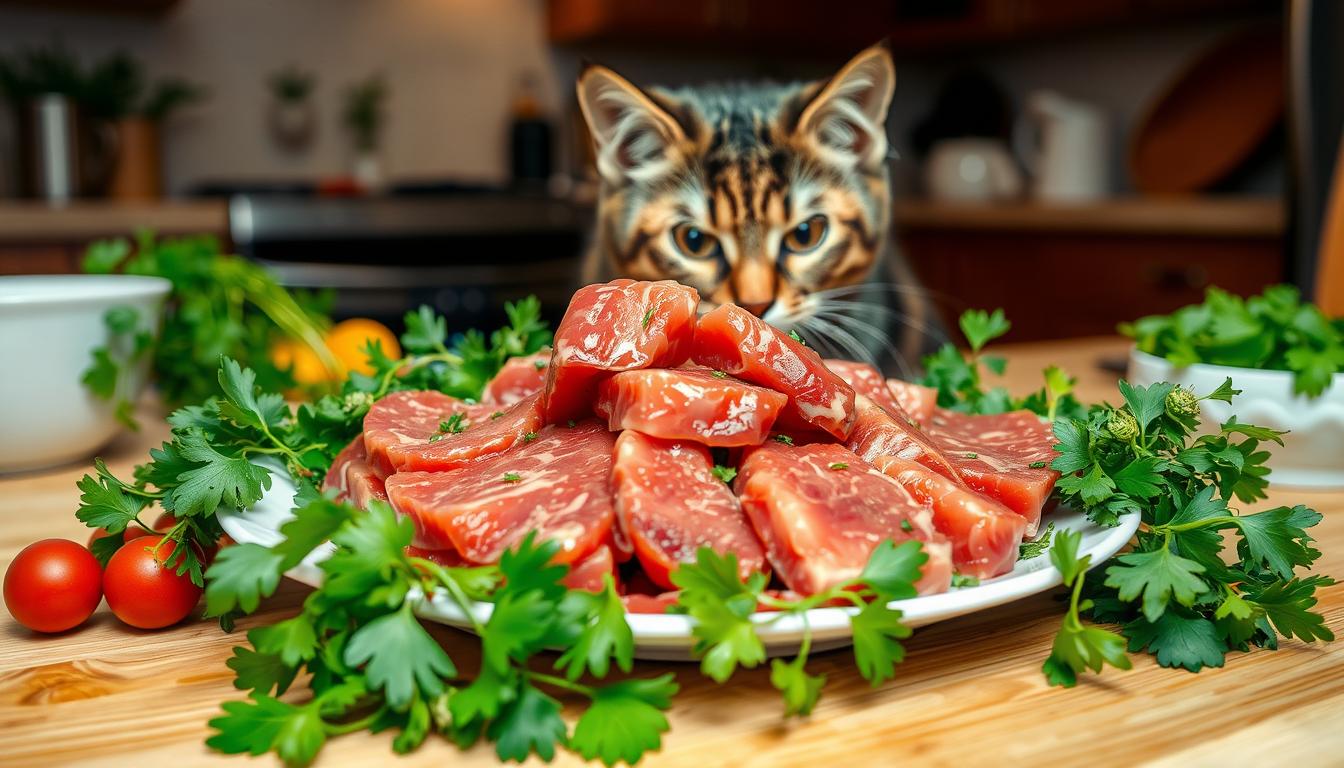As a cat owner, you might wonder if cats can safely eat raw meat. This is a big question that needs careful thought. It affects your cat’s health and happiness. Learning about cats’ natural diet and the pros and cons of raw feeding can guide you.
Cats are meant to eat meat, as they are obligate carnivores. They need animal proteins, fats, and nutrients. In the wild, they eat raw meat, bones, and organs from their prey. This diet is key to understanding what’s best for our cats.
Table of Contents
Understanding Cats as Obligate Carnivores
Cats need to eat mostly animal-based proteins to stay healthy. Unlike dogs, cats can’t get enough nutrients from plants. Their digestive system is made for raw meat and animal nutrients.
Natural Feline Dietary Requirements
Cats should eat a lot of animal protein, about 40-50% of their calories. They also need animal-based fats and special nutrients found in meat, organs, and bones. Without these, cats can get very sick.
Wild Cat Feeding Patterns
Wild cats eat whole prey, including raw meat, bones, and organs. This diet gives them all the vitamins, minerals, and amino acids they need for health and growth.
Essential Nutrients for Cats
- Taurine: Cats can’t make this amino acid on their own. It’s key for heart, eye, and reproductive health.
- Vitamin A: Cats can’t turn beta-carotene into vitamin A. They need it from animal sources.
- Arachidonic acid: This fatty acid is important for skin, coat, and immune health.
It’s important to feed cats a diet rich in these essential nutrients. This helps keep them healthy and happy.
“Cats are obligate carnivores, relying almost entirely on animal flesh to meet their nutritional needs.”
Can Cats Eat Raw Meat: A Veterinary Perspective
Vets have mixed feelings about cats eating raw meat. Cats are meant to eat raw prey, but there are things to think about. These include the safety and nutrition of a raw meat diet for your cat.
A raw meat diet might make cats digest better and boost their immune system. But, vets worry about the dangers like bacteria and not getting enough nutrients.
To lessen these risks, some vets suggest using special raw meat diets that are safe. These diets are treated to kill harmful bacteria. Always talk to your vet before starting a raw meat diet to make sure it’s right for your cat.
| Potential Benefits | Potential Risks |
|---|---|
|
|
Experts agree that raw meat can be good for cats, but only if it’s safe. It’s key to work with your vet to keep your cat healthy and well-fed.
“Ultimately, it’s crucial to consult with your veterinarian before introducing a raw meat diet to ensure it meets your cat’s specific pet health needs.”
Benefits of Raw Meat in Feline Diet
Adding raw meat to your cat’s diet can greatly improve their health. It boosts their digestion and strengthens their immune system. This natural approach to feeding offers many advantages for your pet.
Enhanced Digestibility
Raw meat diets are more easily digested than some processed foods. Studies show that cats on raw diets absorb nutrients better. This leads to better health and energy levels.
Improved Immune System Function
Cats eating raw food may have a stronger immune system. Research finds that raw diets increase white blood cells. This means they can fight off illnesses more effectively.
Natural Nutritional Value
Raw meat diets mirror the natural diet of wild cats. They offer essential nutrients in their most effective form. This supports healthy skin, coat, and overall well-being in your cat.
| Benefit | Description |
|---|---|
| Digestibility | Raw diets have the right mix of nutrients, leading to less body fat in cats. They digest food better and absorb nutrients more efficiently. |
| Immune System | Raw diets promote healthy skin and coat, reducing shedding and keeping fur shiny. They support the immune system with high-quality proteins and bone fibers, vital for gut health. |
| Nutritional Value | Raw bone diets provide calcium and phosphorus for bone health and growth. They also support joint health with chondroitin and glucosamine. Raw diets lead to smaller, less smelly stools due to better digestibility. |
Introducing raw meat to your cat’s diet opens up a world of benefits. It supports their natural nutrition and overall health.
Potential Risks and Safety Concerns
Raw meat can be good for your cat, but it comes with risks. It can have Salmonella, E. coli, and Listeria. These food-borne pathogens can harm your cat and even you and your family.
Raw meat also has parasites like roundworms and tapeworms. These can affect both cats and humans. Plus, small bones in raw meat can be a choking hazard or cause stomach problems.
Homemade raw diets can be unbalanced, which is bad for your cat’s health. Cats with beef allergies should avoid raw beef to stay healthy.
Cats on raw diets can spread harmful bacteria. This is a big risk for other pets and family members. It’s especially dangerous for people with weak immune systems, like young kids, the elderly, or those with health issues.
“The main risk with raw meats is that they may be contaminated with pathogens, posing dangers to cats and their owners.” – Dr. Lisa M. Freeman, Cummings School of Veterinary Medicine
Think carefully about the benefits and risks of a raw meat diet for your cat. Do your research, handle the meat safely, and talk to your vet. This way, you can keep your cat safe and healthy.

Safe Handling and Storage of Raw Meat
Feeding your cat a raw meat diet can be very beneficial. But, it’s important to handle and store the meat safely. This ensures your cat and your family stay healthy.
Temperature Control Guidelines
Keeping raw meat at the right temperature is vital. Store it at below 7°C for carcasses and 3°C for offal. This stops harmful bacteria from growing.
Cross-contamination Prevention
It’s also key to prevent cross-contamination. Use separate areas, utensils, and containers for raw pet food. Always wash your hands with soap and water before and after handling raw meat.
Storage Best Practices
Raw pet food should be stored in a dedicated fridge or freezer. Keep it away from human food. Label and date the raw meat to track its freshness. Discard any leftovers left at room temperature, as they can be dangerous.
By following these guidelines, you can make sure your cat enjoys a raw meat diet safely. Proper storage, temperature control, and preventing cross-contamination are crucial for your cat’s health.
“Proper handling and storage of raw meat is crucial for the health and safety of your cat. Prioritize these guidelines to ensure a safe and nutritious raw diet.”
Types of Raw Meat Suitable for Cats
Feeding your cat a raw diet means knowing the right cat-friendly meats. Cats, being obligate carnivores, need a diet full of feline protein sources. Here are some top raw meats for cats:
- Beef
- Chicken
- Turkey
- Fish
Organ meats like liver and heart are also great for cats. But, give them in small amounts because they’re packed with vitamins and minerals. Raw pork is a no-go because of Trichinella parasites.
Make sure to get raw meat from trusted suppliers with health certifications. A raw diet variety is key for a balanced diet for your cat.
| Meat Type | Recommended Portion | Nutritional Benefits |
|---|---|---|
| Beef | 25-30% of total diet | High in protein, iron, and B vitamins |
| Chicken | 25-30% of total diet | Lean protein, easy to digest |
| Turkey | 25-30% of total diet | Low in fat, high in protein |
| Fish | 10-15% of total diet | Rich in omega-3 fatty acids, vitamins, and minerals |
| Organ Meats (Liver, Heart) | 5-10% of total diet | High in vitamins and minerals, essential for a balanced diet |
Mixing different cat-friendly meats and feline protein sources in your cat’s diet is crucial. It ensures they get all the nutrients they need for health and happiness.

Transitioning Your Cat to Raw Diet
Starting your cat on a raw diet is a step-by-step journey. Begin by adding small amounts of raw meat as treats. This lets your cat get used to the new tastes and textures. Keep an eye out for any signs of upset stomach, like vomiting or diarrhea.
If your cat seems okay, you can slowly add more raw meat. This makes the change smoother for them.
Gradual Introduction Methods
- Start with tiny amounts of raw meat as treats, gradually increasing the portions over the course of a few weeks.
- Mix a small amount of raw food with your cat’s current diet, gradually increasing the raw food ratio.
- Transition your cat to a high-quality wet food first, then slowly introduce raw meat as a topper or mixer.
Monitoring Your Cat’s Response
- Observe your cat’s appetite, energy levels, and overall well-being during the transition.
- Watch for any signs of digestive issues, such as vomiting, diarrhea, or constipation.
- Adjust the pace of the transition if your cat experiences any adverse reactions.
- Consult with your veterinarian if you have any concerns about your cat’s health or the raw diet transition.
The diet transition can take weeks or months, depending on your cat. Kittens might adjust faster to a raw food introduction than adult cats. With patience and careful watching, your cat can enjoy the benefits of a raw diet.
Legal Requirements and Food Safety Standards
Feeding your cat a raw diet requires knowing the legal and safety rules. In the UK, pet food must meet human food standards. Before slaughter, animals are checked by vets to ensure they are healthy.
The Food Standards Agency (FSA) watches over these checks. They make sure pet food makers follow strict cleanliness and safety rules. Even though there’s no law on raw pet food temperature, it’s important to handle and store it safely to avoid contamination.
Some raw pet food companies use special methods to make their food safer. They use high-pressure pasteurization to kill harmful bacteria. This keeps the food safe without losing its nutritional value.
| Regulation | Requirement |
|---|---|
| Federal Food, Drug, and Cosmetic Act (FD&C Act) | Requires that all animal foods, like human foods, must be safe to eat, produced under sanitary conditions, contain no harmful substances, and be truthfully labeled. |
| Low Acid Canned Food Regulations | Canned pet foods must comply with these regulations to ensure they are free of viable microorganisms. |
| Ingredient Approval | Ingredients in pet food must be safe and serve an appropriate function; some do not require pre-market approval, while others must be Generally Recognized As Safe or approved as food additives. |
| Pet Food Labeling | Labels must include proper identification, net quantity statement, manufacturer or distributor information, and all ingredients listed from most to least based on weight. |
The FDA and its partners do inspections based on risk. They check if pet food is made, processed, and stored safely. They focus on areas with compliance issues and hazards.
If pet food doesn’t meet standards, the FDA can take action. This includes asking for fixes, sending advisory letters, recalling products, or stopping production. You can also report concerns to the FDA for them to investigate.
Knowing the laws and safety rules helps you choose the best raw diet for your cat. It ensures your cat stays healthy and happy.
Conclusion
Deciding to add raw meat to your cat’s diet is a big choice. It needs careful thought and advice from your vet. Raw diets might offer better digestion and natural nutrients. But, they also carry risks that must be handled well.
It’s key to get raw meat from safe sources and store it right. This helps avoid foodborne illnesses in your cat.
Your cat’s diet should focus on balanced, natural nutrition. This can be from commercial food or homemade meals. Talk to a vet or a nutritionist to create a diet plan that fits your cat’s needs.
The choice between raw feeding and commercial cat food is personal. But, it’s best made with expert advice. Knowing the risks and benefits helps you choose what’s best for your cat’s health.


2 thoughts on “Can Cats Eat Raw Meat – Safe Feeding Guide”